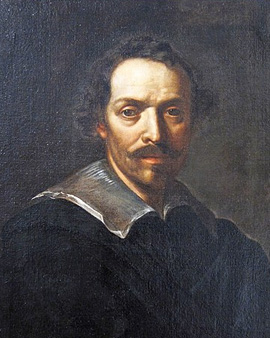On November 1st 1596 Pietro da Cortona was born in a small town called "Cortona" in Tuscany. Together with his personal art teacher Andrea Commodi, he spent his youth in the Italian capital Rome, which served as a great inspiration for his works. The young Cortona particularly liked the paintings and sculptures of Annibale Carracci, who worked as a painter and engraver in Rome. Cortona's style was characterized by detailed objects and robes. Nevertheless, individual brushstrokes were often visible, which was very typical of Italian art at the time. Exceptional for the period, however, were the vividness of his paintings and the use of numerous color effects. Furthermore, his paintings are often covered with a myriad of different figures or scenes, which gives his works an impressive, majestic character.
One of his greatest works was the artistic design of the ceiling of the hall of Palazzo Barberini in Rome. The fresco, entitled "Allegory of Divine Providence and Barberini's Power", was one of the main reasons for Cortona's great influence on the art scene of the time. When looking at the picture, one gets the impression that one is looking far into the sky. Cortona is one of the co-founders of the monumental ceiling fresco as well as one of the most important representatives of the Roman High Baroque.
Cortona was also a successful architect and master builder. Although he invested relatively little time in these professions compared to painting, his ideas were all the more innovative: for example, he designed the unique facade of the church "Santa Maria della Pace" in Rome. Unlike his predecessors, he saw far more than a flat surface in the façade and designed it and the church's forecourt in the style of the Roman Baroque. The interplay between elevations and depressions makes the façade appear lively and dynamic - a method similar to the one he already used for his wall and ceiling frescos. He also produced numerous anatomical drawings over a period of five years. For this purpose he participated as an observer in corpse openings and subsequently produced the corresponding works. The special thing about it: Cortona combined those anatomical drawings with elements of other styles. For example, he placed a woman whose abdomen had been cut open in front of classical antique columns.
×





.jpg)
.jpg)
.jpg)
.jpg)
.jpg)
.jpg)
_Cortona_-_The_glory_of_the_Barberini_The_Triumph_of_Divine_Providence_Allegory_of_Providen_-_(MeisterDrucke-988289).jpg)
_Cortona_-_The_glory_of_the_Barberini_The_Triumph_of_Divine_Providence_Allegory_of_Providen_-_(MeisterDrucke-988289).jpg)
_Cortona_-_Allegory_of_the_four_ages_the_Silver_age_Fresco_by_Pietro_da_Cortona_(Stone_of_C_-_(MeisterDrucke-1058596).jpg)
_Cortona_-_Allegory_of_the_four_ages_the_Silver_age_Fresco_by_Pietro_da_Cortona_(Stone_of_C_-_(MeisterDrucke-1058596).jpg)
.jpg)
.jpg)
_Cortona_-_Allegory_of_the_four_ages_the_golden_age_Fresco_by_Pietro_da_Cortona_(Stone_of_C_-_(MeisterDrucke-1053862).jpg)
_Cortona_-_Allegory_of_the_four_ages_the_golden_age_Fresco_by_Pietro_da_Cortona_(Stone_of_C_-_(MeisterDrucke-1053862).jpg)
.jpg)
.jpg)
.jpg)
.jpg)
_Cortona_-_The_Triumph_of_Bacchus_by_Pietro_da_Cortona_(1596-1669)_-_(MeisterDrucke-1083532).jpg)
_Cortona_-_The_Triumph_of_Bacchus_by_Pietro_da_Cortona_(1596-1669)_-_(MeisterDrucke-1083532).jpg)
_Cortona_-_The_Triumph_of_Divine_Providence_Detail_of_the_painting_of_Stone_of_Cortona_(Pie_-_(MeisterDrucke-999482).jpg)
_Cortona_-_The_Triumph_of_Divine_Providence_Detail_of_the_painting_of_Stone_of_Cortona_(Pie_-_(MeisterDrucke-999482).jpg)
_Being_Led_to_Her_Martyrdom_-_(MeisterDrucke-1559932).jpg)
_Being_Led_to_Her_Martyrdom_-_(MeisterDrucke-1559932).jpg)
.jpg)
.jpg)
.jpg)
.jpg)
_Cortona_-_Cesar_puts_Cleopatre_back_on_the_throne_of_Egypt_Jules_Cesar_gives_the_throne_of_-_(MeisterDrucke-960858).jpg)
_Cortona_-_Cesar_puts_Cleopatre_back_on_the_throne_of_Egypt_Jules_Cesar_gives_the_throne_of_-_(MeisterDrucke-960858).jpg)
.jpg)
.jpg)
.jpg)
.jpg)
_-_(MeisterDrucke-1277815).jpg)
_-_(MeisterDrucke-1277815).jpg)
_Cortona_-_The_Abduction_of_the_Sabines_Painting_by_Pietro_da_Cortona_(Stone_of_Cortona)_(P_-_(MeisterDrucke-988291).jpg)
_Cortona_-_The_Abduction_of_the_Sabines_Painting_by_Pietro_da_Cortona_(Stone_of_Cortona)_(P_-_(MeisterDrucke-988291).jpg)
_Cortona_-_Cosimo_I_de_Medici_(Cosimo_I_de_Tuscany_led_in_front_of_Jupiter_by_Victory_and_H_-_(MeisterDrucke-984499).jpg)
_Cortona_-_Cosimo_I_de_Medici_(Cosimo_I_de_Tuscany_led_in_front_of_Jupiter_by_Victory_and_H_-_(MeisterDrucke-984499).jpg)
.jpg)
.jpg)
.jpg)
.jpg)
.jpg)
.jpg)
_Cortona_-_Urban_VIII_carried_down_the_nave_of_St_Peters_(pen_brown_ink_with_body_colour_o_-_(MeisterDrucke-1092437).jpg)
_Cortona_-_Urban_VIII_carried_down_the_nave_of_St_Peters_(pen_brown_ink_with_body_colour_o_-_(MeisterDrucke-1092437).jpg)
_Cortona_-_Caesar_giving_Cleopatra_the_Throne_of_Egypt_c1637_(oil_on_canvas)_-_(MeisterDrucke-911936).jpg)
_Cortona_-_Caesar_giving_Cleopatra_the_Throne_of_Egypt_c1637_(oil_on_canvas)_-_(MeisterDrucke-911936).jpg)
.jpg)
.jpg)
.jpg)
.jpg)
 Consecrating the Church of Sant - (MeisterDrucke-286927).jpg)
 Consecrating the Church of Sant - (MeisterDrucke-286927).jpg)
.jpg)
.jpg)
_Cortona_-_Pope_Urban_VIII_c1624-27_(oil_on_canvas)_-_(MeisterDrucke-1315294).jpg)
_Cortona_-_Pope_Urban_VIII_c1624-27_(oil_on_canvas)_-_(MeisterDrucke-1315294).jpg)
 - (MeisterDrucke-242856).jpg)
 - (MeisterDrucke-242856).jpg)
.jpg)
.jpg)
_Cortona_-_Cosimo_I_de_Medicis_(Cosimo_I_of_Tuscany)_(1519-1574)_Guide_through_Glory_and_Vi_-_(MeisterDrucke-984500).jpg)
_Cortona_-_Cosimo_I_de_Medicis_(Cosimo_I_of_Tuscany)_(1519-1574)_Guide_through_Glory_and_Vi_-_(MeisterDrucke-984500).jpg)
.jpg)
.jpg)
_Cortona_-_Venus_as_a_hunter_appears_in_Enee_Painting_by_Pierre_de_Cortona_(Pietro_Berretti_-_(MeisterDrucke-987999).jpg)
_Cortona_-_Venus_as_a_hunter_appears_in_Enee_Painting_by_Pierre_de_Cortona_(Pietro_Berretti_-_(MeisterDrucke-987999).jpg)
_Cortona_-_Assumption_of_the_Virgin_Fresco_by_Pietro_da_Cortona_(Peter_of_Cortona)_(1596-16_-_(MeisterDrucke-1062546).jpg)
_Cortona_-_Assumption_of_the_Virgin_Fresco_by_Pietro_da_Cortona_(Peter_of_Cortona)_(1596-16_-_(MeisterDrucke-1062546).jpg)
.jpg)
.jpg)
.jpg)
.jpg)
_-_(MeisterDrucke-1364804).jpg)
_-_(MeisterDrucke-1364804).jpg)
_Cortona_-_Young_man_study_-_Drawing_-_(MeisterDrucke-973765).jpg)
_Cortona_-_Young_man_study_-_Drawing_-_(MeisterDrucke-973765).jpg)
_Cortona_-_Allegory_of_the_four_ages_the_Bronze_age_fresco_by_Pietro_da_Cortona_(Stone_of_C_-_(MeisterDrucke-1058597).jpg)
_Cortona_-_Allegory_of_the_four_ages_the_Bronze_age_fresco_by_Pietro_da_Cortona_(Stone_of_C_-_(MeisterDrucke-1058597).jpg)
.jpg)
.jpg)
 with an Audience 1620 - (MeisterDrucke-68117).jpg)
 with an Audience 1620 - (MeisterDrucke-68117).jpg)
.jpg)
.jpg)
_Cortona_-_Mars_after_the_war_vault_of_the_Hall_of_Mars_-_(MeisterDrucke-996488).jpg)
_Cortona_-_Mars_after_the_war_vault_of_the_Hall_of_Mars_-_(MeisterDrucke-996488).jpg)
.jpg)
.jpg)
.jpg)
.jpg)
.jpg)
.jpg)
 Being Led to Her Martyrdom - (MeisterDrucke-6433).jpg)
 Being Led to Her Martyrdom - (MeisterDrucke-6433).jpg)
_Cortona_-_Arms_of_Don_Taddeo_Barberini_Principe_di_Palestrina_(pen_ink_with_wash_and_goua_-_(MeisterDrucke-1081113).jpg)
_Cortona_-_Arms_of_Don_Taddeo_Barberini_Principe_di_Palestrina_(pen_ink_with_wash_and_goua_-_(MeisterDrucke-1081113).jpg)
_Cortona_-_Laban_Seeking_his_Idols_(oil_on_canvas)_-_(MeisterDrucke-901437).jpg)
_Cortona_-_Laban_Seeking_his_Idols_(oil_on_canvas)_-_(MeisterDrucke-901437).jpg)
.jpg)
.jpg)
.jpg)
.jpg)
_Cortona_-_The_Virgin_appears_to_Saint_Philip_Neri_(Filippo_Neri)_during_the_construction_o_-_(MeisterDrucke-946561).jpg)
_Cortona_-_The_Virgin_appears_to_Saint_Philip_Neri_(Filippo_Neri)_during_the_construction_o_-_(MeisterDrucke-946561).jpg)
.jpg)
.jpg)
_Cortona_-_Female_figure_Study_for_the_Age_of_Silver_fresco_-_(MeisterDrucke-1089164).jpg)
_Cortona_-_Female_figure_Study_for_the_Age_of_Silver_fresco_-_(MeisterDrucke-1089164).jpg)
_Cortona_-_The_young_Cosimo_I_of_Medici_(Cosimo_I_of_Tuscany)_(1519-1574)_is_taken_from_the_-_(MeisterDrucke-946559).jpg)
_Cortona_-_The_young_Cosimo_I_of_Medici_(Cosimo_I_of_Tuscany)_(1519-1574)_is_taken_from_the_-_(MeisterDrucke-946559).jpg)
_Cortona_-_Hands_and_arms_study_for_The_Golden_Acortonage_fresco_-_(MeisterDrucke-1090933).jpg)
_Cortona_-_Hands_and_arms_study_for_The_Golden_Acortonage_fresco_-_(MeisterDrucke-1090933).jpg)
.jpg)
.jpg)
.jpg)
.jpg)
.jpg)
.jpg)
 - (MeisterDrucke-254099).jpg)
 - (MeisterDrucke-254099).jpg)
_-_(MeisterDrucke-1265215).jpg)
_-_(MeisterDrucke-1265215).jpg)
_Cortona_-_Recovering_of_St_Philip_after_apparition_of_the_virgin_Fresco_of_the_entourage_b_-_(MeisterDrucke-951512).jpg)
_Cortona_-_Recovering_of_St_Philip_after_apparition_of_the_virgin_Fresco_of_the_entourage_b_-_(MeisterDrucke-951512).jpg)
.jpg)
.jpg)
_Cortona_-_The_Sala_di_Apollo_(Hall_of_Apollo)_detail_of_ceiling_decoration_depicting_Alexa_-_(MeisterDrucke-1019679).jpg)
_Cortona_-_The_Sala_di_Apollo_(Hall_of_Apollo)_detail_of_ceiling_decoration_depicting_Alexa_-_(MeisterDrucke-1019679).jpg)
.jpg)
.jpg)
.jpg)
.jpg)
_(after)_Cortona_-_Plate_V_from_Tabulae_Anatomicae_-_(MeisterDrucke-891259).jpg)
_(after)_Cortona_-_Plate_V_from_Tabulae_Anatomicae_-_(MeisterDrucke-891259).jpg)
.jpg)
.jpg)
.jpg)
.jpg)
_Cortona_-_Study_for_theatre_in_Palazzo_Pitti_in_Florence_by_Pietro_Berrettini_known_as_Pie_-_(MeisterDrucke-1088756).jpg)
_Cortona_-_Study_for_theatre_in_Palazzo_Pitti_in_Florence_by_Pietro_Berrettini_known_as_Pie_-_(MeisterDrucke-1088756).jpg)
.jpg)
.jpg)
.jpg)
.jpg)
_(after)_Cortona_-_Romulus_and_Remus_Engraving_after_the_painting_by_Pietro_da_Cortone_Engraving_fr_-_(MeisterDrucke-924389).jpg)
_(after)_Cortona_-_Romulus_and_Remus_Engraving_after_the_painting_by_Pietro_da_Cortone_Engraving_fr_-_(MeisterDrucke-924389).jpg)
_Cortona_-_Return_of_Hagar_-_Pietro_da_Cortona_(1596-1669)_Oil_on_canvas_ca_1637_Dimension_-_(MeisterDrucke-959803).jpg)
_Cortona_-_Return_of_Hagar_-_Pietro_da_Cortona_(1596-1669)_Oil_on_canvas_ca_1637_Dimension_-_(MeisterDrucke-959803).jpg)
_Cortona_-_The_return_of_Agar_Agar_the_Egyptian_slave_of_Sarah_Abrahams_wife_Drawing_in_bla_-_(MeisterDrucke-945865).jpg)
_Cortona_-_The_return_of_Agar_Agar_the_Egyptian_slave_of_Sarah_Abrahams_wife_Drawing_in_bla_-_(MeisterDrucke-945865).jpg)
_Cortona_-_Antique_sacrifice_and_the_marriage_of_Perseus_and_Andromeda_after_Polidoro_da_Ca_-_(MeisterDrucke-1093757).jpg)
_Cortona_-_Antique_sacrifice_and_the_marriage_of_Perseus_and_Andromeda_after_Polidoro_da_Ca_-_(MeisterDrucke-1093757).jpg)
.jpg)
.jpg)
.jpg)
.jpg)
 - (MeisterDrucke-6444).jpg)
 - (MeisterDrucke-6444).jpg)
.jpg)
.jpg)
.jpg)
.jpg)
.jpg)
.jpg)
.jpg)
.jpg)
.jpg)
.jpg)
_-_Alexander_de_Grote_neemt_de_stad_Petra_in_-_(MeisterDrucke-1370310).jpg)
_-_Alexander_de_Grote_neemt_de_stad_Petra_in_-_(MeisterDrucke-1370310).jpg)
_-_(MeisterDrucke-875907).jpg)
_-_(MeisterDrucke-875907).jpg)
_-_H_Carolus_Borromeus_draagt_een_crucifix_langs_slachtoffers_van_de_pest_-_(MeisterDrucke-1361031).jpg)
_-_H_Carolus_Borromeus_draagt_een_crucifix_langs_slachtoffers_van_de_pest_-_(MeisterDrucke-1361031).jpg)
.jpg)
.jpg)
.jpg)
.jpg)
_River_Estuary_(verso)_-_(MeisterDrucke-1271780).jpg)
_River_Estuary_(verso)_-_(MeisterDrucke-1271780).jpg)
.jpg)
.jpg)
.jpg)
.jpg)
.jpg)
.jpg)
.jpg)
.jpg)
_Cortona_-_Venus_study_for_Triumph_of_Divine_Providence_fresco_on_vault_in_hall_at_Palazzo_-_(MeisterDrucke-1082271).jpg)
_Cortona_-_Venus_study_for_Triumph_of_Divine_Providence_fresco_on_vault_in_hall_at_Palazzo_-_(MeisterDrucke-1082271).jpg)
.jpg)
.jpg)
.jpg)
.jpg)
.jpg)
.jpg)






